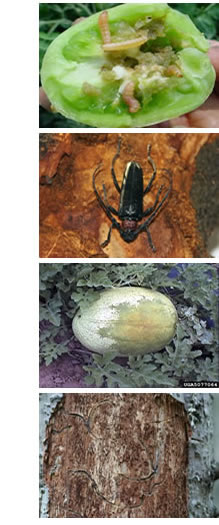
49th Meeting of the Panel on Phytosanitary Measures
Paris, 2014-03-04/06
 The Panel met in Paris in the EPPO headquarters on 2014-03-04/06 (download a list of participants). The main task of this Panel is to evaluate risks presented by specific pests and design phytosanitary measures to avoid their introduction and spread. The Panel reviewed its Terms of Reference. They will be presented to the Working Party on Phytosanitary Regulations.
The Panel met in Paris in the EPPO headquarters on 2014-03-04/06 (download a list of participants). The main task of this Panel is to evaluate risks presented by specific pests and design phytosanitary measures to avoid their introduction and spread. The Panel reviewed its Terms of Reference. They will be presented to the Working Party on Phytosanitary Regulations.
EPPO lists of pests recommended for regulation
On a case by case basis, the Panel reviewed in detail PRAs prepared by the Expert Working Groups for PRA and performed pest risk management when necessary, and it also reviewed national PRAs. The Panel recommended to the Working Party the addition to the A1 List of Neoleucinodes elegantalis and Aromia bungii; and the addition to the A2 List of Polygraphus proximus, and Acidovorax citrulli.
The Panel considered pest risk management options for Oemona hirta for wood commodities.
The Panel reviewed the present situation of A1 pests and considered that no pests should be transferred from the A1 to the A2 List although the situation of Anoplophora glabripennis and Dacus ciliatus should be reviewed next year.
Alert List
The Panel reviewed the EPPO Alert List (the purpose of this List is to warn countries about possible new risks, and in certain cases to propose candidates for PRA and eventually regulation). Considering that the alert had been given and that no further action was needed, the Panel decided to delete Chrysophtharta bimaculata, Hymenoscyphus pseudoalbidus (anamorph Chalara fraxinea), Pseudomonas syringae pv. aesculi. The Panel suggested some emerging pests that could be added to the Alert List (e.g. Euwallacea fornicatus; Xyleborus glabratus, Scutellonema bradys, Heterodera elaschista, Igutettix oculatus, Megacopta cribaria).
Tomato study
The Panel reviewed the EPPO Study on pest risks associated with the import of tomato fruit aims. A number of pests that may be associated with tomato fruit and may present a risk for the EPPO region have been identified and documented. The Panel considered that this selection of pests, together with the fact that some pests associated to tomato fruit are already recommended or proposed for regulation by EPPO (such as Keiferia lycopercicella, Neoleucinodes elegantalis, Bactericera cockerelli and Candidatus Liberibacter solanacearum) is sufficient to justify a general phytosanitary import requirement for a phytosanitary certificate for tomato fruit from all origins, thereby ensuring that tomato fruit are inspected at export. The Working Party on Phytosanitary Regulations will be asked its opinion on this recommendation as well as feedback on the general process and the usefulness of such a commodity study.
Pest Risk Analysis
In addition to the review of PRAs (see above) the Panel established the priorities for the organization of EWGs for PRA. The selection was made taking into account the following elements: geographical distribution, importance of the crop(s) concerned, risk of natural spread into the region or for further spread within the region, potential pathways, economic impact, environmental impact, possibilities of control, similarities to other known cases, availability and validity of data. The Panel agreed that the thousand cankers disease (Geosmithia morbida and its insect vector Pityophthorus juglandis) was the highest priority for PRA. Heterobasidion irregulare is the second priority. This will be further discussed by the Working Party. Some pests may also be selected from the Tomato Study.
PRA process
The Panel discussed the EPPO PRA process, from early warning to recommendation for listing quarantine pests. It underlined that early warning is a key role of EPPO. The Panel also discussed how PRAs should be performed to be ‘fit for purpose’. It was considered that more PRAs may be produced following EPPO Standard PM 5/5(1) Decision-Support Scheme for an Express Pest Risk Analysis. The Panel also considered that more commodity PRAs may be performed.
The EPPO PRA process will be further discussed by the Working Party.
Horizontal issues
The Panel discussed the concept of ‘complete physical protection’ and its interpretation by exporting countries and further elaborated a document to provide guidance on how to implement complete physical protection and define detailed requirements for specific pests.
The Panel discussed whether the requirements that an exporting country should certify that a consignment originate from a Pest-Free Area should be applied to all countries, including those from which a pest is not known to occur.
Phytosanitary regulations in EPPO member countries
Mr Tryakhov presented the work on phytosanitary issues within the newly created Eurasian Economic Commission (agreement between Belarus, Kazakhstan and the Federation of Russia). Mr Cardon (EU Commission) updated the Panel on the implementation of EPPO recommendations within EU countries. It was noted that EPPO PRAs are used to support EU regulations.
The next Panel meeting is planned in Turkey on 2014-10-28/30.
